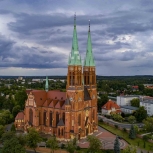
Rybnik
In the context of the ALT/BAU Transfer Network, some major problems of Rybnik are linked to suburbanisation processes. As a result of the deteriorating demographic structure of the city centre (increasing proportion of elderly population, changes in household structures), there is a progressive depopulation mechanism in this very district. Effectively, the number of empty or abandoned buildings, including communal buildings and apartments, is increasing. The lack of attractiveness of downtown, especially for young people, is also the result of air pollution
and very heavy local traffic.
Therefore, the main objective of Rybnik authorities in terms of housing management is to increase attractiveness of the city centre, especially among young people. One of the basic elements of this new housing policy will be development of vacant and derelict buildings and flats, the construction of new dwellings on unused areas and cooperation with housing cooperatives, private owners and all other stakeholders interested in improving the cityscape of Rybnik’s city centre.
Chemnitz and Rybnik have several features in common: Both cities have a population of more than 100 000 people, cover a relatively large area with number of districts and are among the 30 largest cities in their respective countries. It is also noteworthy that after European tremendous political changes in early 1990s, both Rybnik and Chemnitz with their rich industrial heritage began a new period of development in a free market.
These general similarities of both cities, with some differences at the same time, related to housing policy and ways of reviving empty and abandoned buildings and flats, can be a great opportunity to learn and share experiences in this field.
SOME RELATED NETWORKS
ALT/BAU
News



